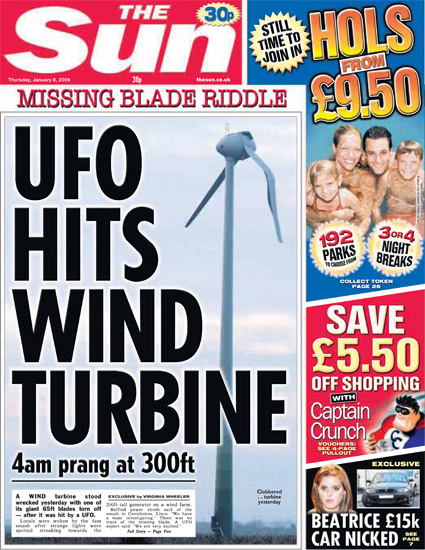This post was written by Simon Mahan, former Energy Resources Policy Manager for SACE.
Guest Blog | January 5, 2015 | Energy Policy, Wind
This post is part of the “Prelude to Paris” series highlighting updates and analysis on international climate negotiations in the lead up to the United Nations climate change conference – the 21st Conference of the Parties (COP 21) — to be held in Paris this December. Other posts in the series are available here.
The Wind Tree by NewWind is making the social media rounds. Videos, blogs, pictures and ecstatic exclamations of “Huzzah! The future is now!” are blanketing the internet. The Wind Tree will be on display in Paris for the lead up to the Paris climate conference later this year. If one of your New Year’s resolutions is to be skeptical of everything on the internet, this is a good place to start. Here are eight reasons to be skeptical of the Wind Tree.
1. It’s purely for aesthetics.
Wind turbines are fairly standardized with three blades with a horizontal axis (not a vertical axis like the Wind Tree). There’s a reason why large scale wind turbines all pretty much look the same – they work. The only reason to go radically different is for aesthetic purposes (viewshed, visual pleasure), which may dramatically compromise performance.
2. Ever heard of “wake effect?”
Wake effect occurs when the wind is blocked by a structure and a downwind structure receives the remaining wind. Think of the wind like a river: if you throw in a boulder, the water ripples around the rock and slows immediately behind it. Putting wind turbines too closely together cause some turbines to not reach peak efficiency, thus reducing energy output and increasing overall costs. Also, wind wakes are a form of turbulence, which can cause excessive and unexpected wear and tear on a wind turbine.

3. Making a wind turbine look like a bird’s natural habitat isn’t a great idea.
Wind energy is some of the most environmentally sound power available. Wind power has been estimated to be 17x safer for birds than fossil fuels. However, early wind turbines with lattice towers (instead of the current tubular towers) were more dangerous for birds. Lattice towers attracted more birds by acting like perches. And attracting more birds to manmade structures has a tendency to increase bird mortality.
4. Short turbines don’t produce a lot of energy.
Supposedly, “You only need half the wind!” for the Wind Tree. However, you don’t get the same amount of electricity generation. It may be true that the Wind Tree may have some leaves spinning in wind speeds of 4.5 miles per hour (2 meters per second), but they’re certainly not generating a lot of energy. They just can’t. Lower wind speeds physically contain less energy than higher wind speeds, thus there’s less energy to capture. The higher you go, the better the winds. And wind turbines are growing taller in order to capture greater wind speeds and reduce costs.
5. It’s way more expensive than just about every other form of power generation.
At $37,000 per Wind Tree, the total capacity is rated at 3.1 kilowatts. That’s a cost of $11,935 per kW (Presuming that’s the total installed price, and not just the price of the Wind Tree. Also presuming that kilowatts figure is in AC power, not DC.). Large scale wind turbines cost about $1,700 per kW, installed – or about 85% cheaper than the Wind Tree. Or you could buy about three times as much solar power for the same price as the Wind Tree. And these are just the capital costs, not to mention energy output efficiencies.
6. It won’t pay for itself in 2 years.
The blogosphere seems to believe the Wind Tree will pay for itself in “2 years”, which simply isn’t true. Each 3.1 kilowatt tree would be able to produce 54,312 kilowatt hours over the course of two years – so long as the wind never stopped and the winds were much higher than the 4.5 mph wind speeds stated earlier (or in industry terms, a 100% capacity factor…an impossibility). At that impossible level of production, electricity would have to cost $0.68 per kilowatt hour to achieve the 2 year return. That’s about seven times higher than the average US electric price.
7. It won’t power most of your home.
The average home consumes about 12,000 kilowatt hours per year. The Wind Tree, which is similar to other vertical axis wind turbines in urban areas, has a total capacity of 3.1 kilowatts and may be able to achieve capacity factors of 6-13% (based on this research). Under the most optimistic estimates, each Wind Tree would only generate 3,530 kilowatt hours per year – you’d need at least four Wind Trees to power your home. (By the way, at 3,530 kilowatt hours per year and $0.10 per kilowatt hour, it’d take 105 years to repay the initial $37,000 investment).

8. It won’t win over anti-wind activists.
The whole point of the Wind Tree is to be so aesthetically pleasing that no one will oppose wind energy (price be damned!). But anti-wind activists will assuredly find something to complain about. By trying to appease the aesthetics crowd, the Wind Tree could very well spur a higher level of opposition based on the price alone. The Wind Tree may very well represent one step forward and two steps back to win over anti-wind activists.
But there is a silver lining…
The buzz about the Wind Tree shows that lots of people, regular folks that don’t regularly care about where their energy comes from, are clearly interested in new renewable energy technologies. And existing renewable energy technologies are rapidly being adopted globally at breakneck speeds. While it’s great that innovators are still evaluating different ways to produce clean power, don’t lose sight of how amazing the more mainstream technologies already are: Electricity from the air and sun for dirt cheap. Welcome to 2015!